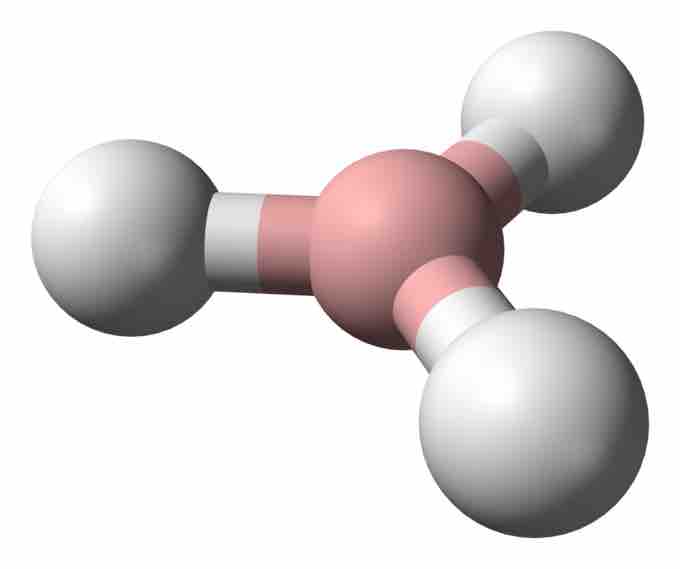Boranes are chemical compounds of boron and hydrogen. The boranes comprise a large group of compounds with the generic formula of BxHy. These compounds do not occur in nature. Many of the boranes readily oxidize on contact with air, some violently. The parent member BH3 is called borane, is known only in the gaseous state, and dimerizes to form diborane, B2H6.
The larger boranes all consist of boron clusters that are polyhedral, some of which exist as isomers. For example, isomers of B20H26 are based on the fusion of two 10-atom clusters. The most important boranes are diborane B2H6, pentaborane B5H9, and decaborane B10H14. The development of the chemistry of boron hydrides led to new experimental techniques and theoretical concepts. Boron hydrides have been studied as potential fuels, for rockets, and for automotive uses.

Borane
Ball-and-stick model of borane, BH3, which is highly reactive.
The names for the series of boranes are derived from this general scheme for the cluster geometries:
- hypercloso- (from the Greek for "over cage") a closed complete cluster (e.g., B8Cl8 is a slightly distorted dodecahedron)
- closo- (from the Greek for "cage") a closed complete cluster (e.g., icosahedral B12H122−)
- nido- (from the Latin for "nest") B occupies n vertices of an n+1 deltahedron (e.g., B5H9 an octahedron missing one vertex)
- arachno- (from the Greek for "spiders web") B occupies n vertices of an n+2 deltahedron (e.g., B4H10 an octahedron missing two vertices)
- hypho- (from the Greek for "net") B occupies n vertices of an n+3 deltahedron (e.g., possibly B8H16 has this structure, an octahedron missing three vertices)
- conjuncto- two or more of the above are fused together (e.g., the edge or two vertex fused B19H221−, face or three vertex fused B21H181−, and four vertex fused B20H16)
Boranes are all colorless and diamagnetic. They are reactive compounds and some are pyrophoric. The majority are highly poisonous and require special handling precautions. Properties and reactivity:
- closo− There is no known neutral closo borane. Salts of the closo anions, BnHn2− are stable in neutral aqueous solution, and their stabilities increase with size.
- nido− Pentaborane(9) and decaborane(14) are the most stable nido−boranes, in contrast to nido−B8H12, which decomposes above -35o.
- arachno− Generally these are more reactive than nido−boranes; again, larger compounds tend to be more stable.
Typical reactions of boranes are:
- electrophilic substitution
- nucleophilic substitution by Lewis bases
- deprotonation by strong bases
- cluster building reactions with borohydrides
- reaction of a nido-borane with an alkyne to give a carborane cluster
Boranes can act as ligands in coordination compounds. Boranes can react to form hetero-boranes (e.g., carboranes or metalloboranes), clusters that contain boron and metal atoms.